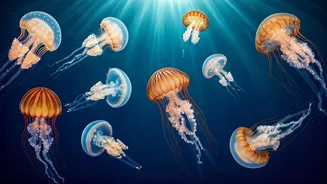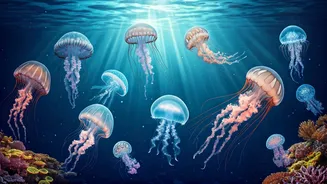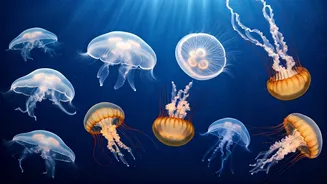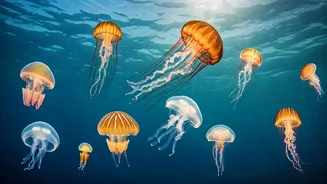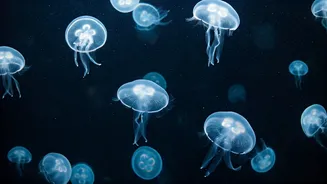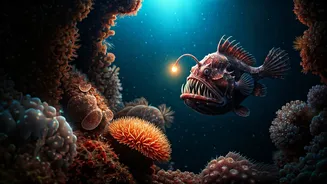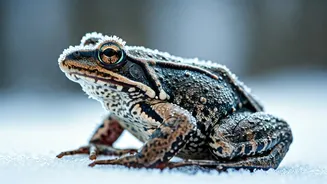Introduction: Jellyfish's Allure
Jellyfish, despite their simple appearance, are ancient and highly successful organisms, existing for over 500 million years. They are found in oceans
worldwide and exhibit incredible diversity. These mesmerizing creatures, often called 'jellies,' come in various shapes, sizes, and colors, captivating scientists and marine enthusiasts alike. This article will journey into the captivating world of jellyfish, revealing the beauty and intricacies of ten unique species. We will uncover their distinct characteristics, survival adaptations, and the ecological importance they hold within their aquatic habitats. Prepare to be astounded by the wonders of these aquatic marvels.
Moon Jelly: Ubiquitous Beauty
The Moon Jelly (Aurelia aurita) is one of the most widely recognized jellyfish, characterized by its translucent, moon-like bell shape. It typically reaches up to 25 cm in diameter. Moon jellies are nearly transparent, allowing glimpses of their internal structures. They possess short tentacles along the bell’s rim that gather food. Their diet mainly consists of plankton. The Moon Jelly's distribution spans across oceans globally, making it a common sight in coastal waters. These jellies are known for their resilience and can reproduce both sexually and asexually, ensuring their continued presence in diverse marine ecosystems. Their delicate beauty provides a crucial role in the food web.
Lion's Mane: Giant of Seas
The Lion's Mane Jellyfish (Cyanea capillata) is the largest known species of jellyfish, with bells that can surpass 2 meters in diameter and tentacles reaching over 36 meters long, making it among the longest animals on Earth. Found in cold, northern waters, this jellyfish boasts a vibrant array of colors, from red and orange to brown. The tentacles, which trail from its bell, are filled with stinging cells (nematocysts) used to capture prey, such as fish and smaller jellyfish. Its size makes it a top predator in its habitat, contributing significantly to the marine food chain. Although impressive, this jellyfish can pose a threat to swimmers due to its potent sting.
Box Jellyfish: Deadly Hunter
Box Jellyfish (class Cubozoa) are infamous for their potent venom and box-shaped bells, which gives them their name. Found mainly in tropical and subtropical waters, their square-shaped bells and complex eyes set them apart from other jellyfish. They are known for their active hunting behaviors. They use venom to quickly paralyze prey, primarily small fish. The sting of certain box jellyfish species is among the most venomous in the world, capable of causing severe pain, paralysis, and even death in humans. Their potent venom highlights their place as one of the most dangerous marine animals. Scientific studies are still working on how to understand and treat the sting.
Portuguese Man-of-War: Floating Colony
The Portuguese Man-of-War (Physalia physalis) is often mistaken for a jellyfish, but it's actually a siphonophore, a colony of specialized, interdependent organisms working together. This striking creature is recognizable by its gas-filled bladder, which floats above the water's surface, and long, trailing tentacles below. The tentacles, which can extend up to 30 meters, are equipped with stinging cells used to capture small fish and other prey. They are found in warm waters worldwide and are often propelled by wind and ocean currents. While their sting is painful to humans, it is rarely fatal. Their unusual biology makes them an intriguing example of colonial life.
Flower Hat Jelly: Exotic Beauty
The Flower Hat Jellyfish (Olindias formosa) is known for its exquisite beauty, resembling a blooming flower. This species, found in the warmer waters of the Pacific and Indian Oceans, features a bell adorned with intricate radial patterns and colorful tentacles. Its unique shape and coloration serve both aesthetic and functional purposes. They actively hunt small fish and crustaceans using their nematocyst-equipped tentacles. Despite their beauty, they possess a venomous sting, cautioning against close contact. These jellies demonstrate nature's artistry with their intricate design and captivating appearance. They usually live near coastal areas.
Upside-Down Jelly: Bottom Dweller
Upside-Down Jellyfish (Cassiopea andromeda) differ from other jellies because they spend most of their time upside down on the seafloor. They live in shallow, tropical waters and exhibit a symbiotic relationship with algae. The algae live within their tissues, providing them with nutrients through photosynthesis. By positioning themselves upside down, the jellies expose the algae to sunlight. Their bell is typically pale, and their oral arms are often frilly and colorful. This unique lifestyle highlights their adaptation to shallow, sunlit environments. They are a fascinating example of how marine creatures can thrive by partnering with other organisms.
Crystal Jelly: Bioluminescent Brilliance
The Crystal Jellyfish (Aequorea victoria) is famous for its bioluminescence. When disturbed, it emits a brilliant green glow. This jellyfish, found in the Pacific Ocean, contains green fluorescent protein (GFP), a substance that has revolutionized biomedical research. GFP has been used to study cellular processes, making it an invaluable tool for scientists. This jellyfish is typically transparent, allowing for its internal structures to be visible, accentuating the impact of its green glow. Its discovery and application of GFP have earned it a significant place in the scientific community. It preys on small plankton in its environment.
Comb Jelly: Ciliated Marvel
Comb Jellies (Ctenophora) are not true jellyfish, but they are often grouped with them due to their gelatinous bodies and marine habitats. These creatures move using rows of cilia, which refract light and produce a shimmering, rainbow effect. Comb jellies are carnivorous, consuming small organisms, and they lack stinging cells, relying instead on sticky cells to capture prey. Found throughout the world's oceans, their diversity is remarkable, coming in various shapes and sizes. They play a vital role in marine ecosystems, contributing to the balance of the food web. Their cilia also add an element of iridescence.
Blue Button: Drifting Beauty
The Blue Button (Porpita porpita) is a small, disc-shaped hydrozoan, often mistaken for a jellyfish. It floats on the surface of the ocean and is easily recognized by its bright blue color. Found in warm and temperate waters, the Blue Button is a colony of polyps and medusae, with a central, gas-filled float that allows it to drift with the currents. It has short tentacles with stinging cells, used to capture small plankton. Its vibrant blue hue stands out against the ocean's surface. Blue Buttons are generally harmless to humans. They are an elegant example of the diverse life that floats on the surface of the sea and play a part in the complex marine ecosystem.
